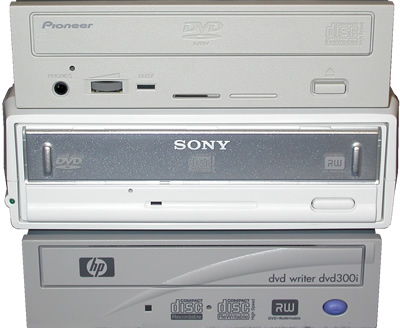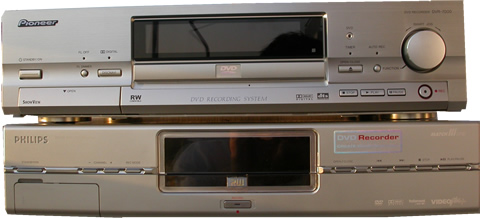DVD Media Format Compatibility Tests
4. Description Of The Tests
Review Pages
The "parameters" of the tests
Since we have decided to check all this media formats compatibility tests by ourselves, in the following we describe how we chose the major parameters of the tests. These certainly include the hardware used for recording, the players for reading the discs, and, of course, the discs themselves, which after all are those about which all this conversation is taking place.
Players
We used 27 stand alone DVD players (of which 2 were also used as recorders) and 20 DVD-ROM PC readers (of which 3 were also used as recorders). Among those 20 DVD-ROM readers, there were also a few recorders, which were used solely as readers in our tests. These where all those drives available to us through the European market and we have been gathering them for over a year now. All the drives used were absolutely new, except some DVD-ROM's we had previously tested for presenting reviews in our web site. Even the latter had been kept out of use until the time of testing and were thus almost-new.
In the following 2 tables the reader can see the exact manufacturer and model used for doing our tests. The first table contains the stand-alone units, the second the PC DVD drives.
Stand alone DVD players.
Some of them are also able to record and 3 of them were used as recorders as well. (See relevant table below.)
| Standalone Players |
| TOSHIBA SD-125E |
| LG DVD5253 |
| PANASONIC DVD-RA 82 |
| PANASONIC DVD-XV10 |
| PHILIPS DVD 723 |
| PHILIPS DVD 890 |
| PHILIPS DVD-640 |
| PIONEER DV-550 |
| PIONEER DVD 7000 |
| SAMSUNG DVD-S224 |
| SONY DVP-F25 |
| AIWA XD-DV370 |
| FirstLine FLAVIO |
| KENWOOD DVF-3530 |
| LG DVD 4710 |
| PANASONIC DVD-RV32 |
| PHILIPS DVD 733 |
| PIONEER DV-343 |
| PIONEER DV-656A |
| SAMSUNG DVD-127 |
| SONY DVP-NS305 |
| SONY DVP-NS705V |
| SONY DVP-PQ1 |
| THOMSON DTH210 |
| TOSHIBA SD-214E |
| TOSHIBA SD-220E |
| YAMAHA DVD-S520 |

PC DVD-ROM Players
| PC DVD-ROM Players |
| AOPEN DVD1648 |
| AOPEN RW125A |
| BTC BDV 316B |
| LITEON LTD-163 |
| LITEON XJ-HD165H |
| MITSUMI DW7801 |
| PHILIPS RW 228 |
| PIONEER DCR-111 |
| PIONEER DVD -105S2 |
| PIONEER DVD -106S2 |
| PIONEER DVD -A05 |
| PIONEER DVD 500M |
| PIONEER DVD-U05S |
| PLEXTOR PX-320A |
| RICOH MP 5125 |
| SONY DRX-500U1 |
| TEAC DV-516E |
| TOSHIBA SD-R1202 |
| WAILE SFINX 16 |
| WAITEC XFILE |
In all cases the most recent firmwares were downloaded or otherwise acquired. Each drive tested had the latest firmware and thus the best performance in terms of writing/reading quality and compatibility with respect to the latest discs on the market.
The recorders
We used as recorders 2 stand alone units and 3 PC drives. In each case we recorded at the maximum speed all types of supported media. In one case (Sony) we recorded media of both formats, since this was supported.

| Recorders |
| Pioneer A05 |
| Pioneer DVR7000 |
| Philips DVDR890 |
| HP dvd 300i |
| Sony DRX-500UL |

Our choice here was based on arguments explained in the previous section. We had to include certainly the major drives from both camp "leaders". Since Ricoh 4x +R/RW recorder was not available when we designed the roadmap of our tests and as its 4x +R media were very scare at that time, we did not include Ricoh drives or media in our tests. We did not include a 4x Philips recorder either, because there is currently no such drive available in the market.
Having said this, we must point out that all major component manufacturers were represented in our tests. The NEC recorder is the same as the HP drive we used in our tests. Based on all those things we have learned over the time by performing exhaustive hardware tests, there is very little difference between drives based on the same hardware components. From this point of view adding or removing drives from the particular list we chose, would have only a marginal impact on the outcome of our tests. (Although would have probably lengthen unacceptably the required time to conduct them!)
The Media
Having selected the recording units as explained previously, we had to choose the respective media according to similar arguments. One media manufacturer had to be the one suggested by the unit manufacturer itself. We thus chose the types of media that are usually being shipped along with the units. In the case of -R/RW recorders, these were the Pioneer discs. In the case, however, of Philips, as 4x +R/ 2.4x +RW media were generally unavailable to us, we chose Verbatim discs which is, nonetheless, the OEM.
We also came under the requirement of a finite amount of time that we could spend on doing the tests. Obviously, we had to use the same exactly persons for doing all the tests. They had to be among our "crew" and be skilful enough to catch quickly and easily each drive's idiosyncrasies and write down clearly the outcome of each test. Each additional media manufacturer would add (27 + 20) x 6 = 282 more tests to be carried out. Having to choose among the perfect and feasible we decided to include only one additional disc manufacturer. It should be one with the greatest market share and among those offering discs of both types and at the maximum recorded speeds.
In both cases the media we chose as a third option was Maxell. A close alternative was to use TDK. But after gathering whatever TDK disc we were able to find in the European market, we soon came at a dead end: We could not find any 4x +R media! (Having done some more informal tests since our original deadline, we can assure our readers that there would be hardly a difference even if we were lucky enough to get the full arsenal of TDK discs.)
Summing up we used:
| Media |
| Pioneer DVD-R 4x |
| Pioneer DVD-RW 2x |
| Maxell DVD-R 4x |
| Maxell DVD-RW 2x |
| Verbatim DVD+R 4x |
| Verbatim DVD+RW 2.4x |
| Maxell DVD+R 4x |
| Maxell DVD+RW 2.4x |
In the case of dual format capable recorders (Sony DRX-500UL) we used, of course, all 8 combinations of the chosen discs.

The speed
We burned all discs in the maximum available speed by each drive. This was done for the following reasons. Each particular drive is factory calibrated to record best at this speed. This is a major factor, as we want to test what is in general the best offer by both camps under the rationale that we should try to minimize the number of reasons causing incompatibilities with older players. Had we chose otherwise, we would both face a much larger number of tests and the possibility of testing something that most of our readers would never use in practice.
Review Pages













